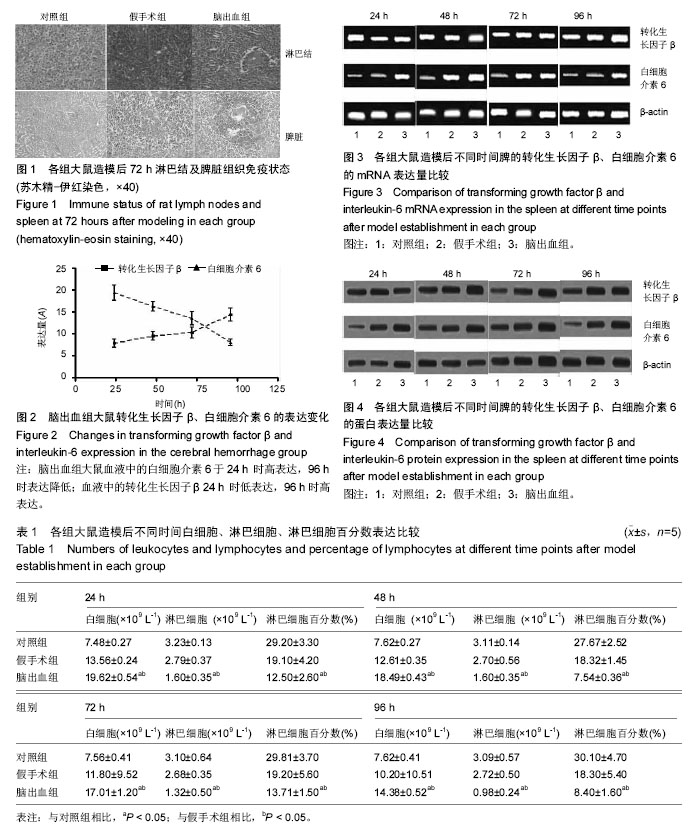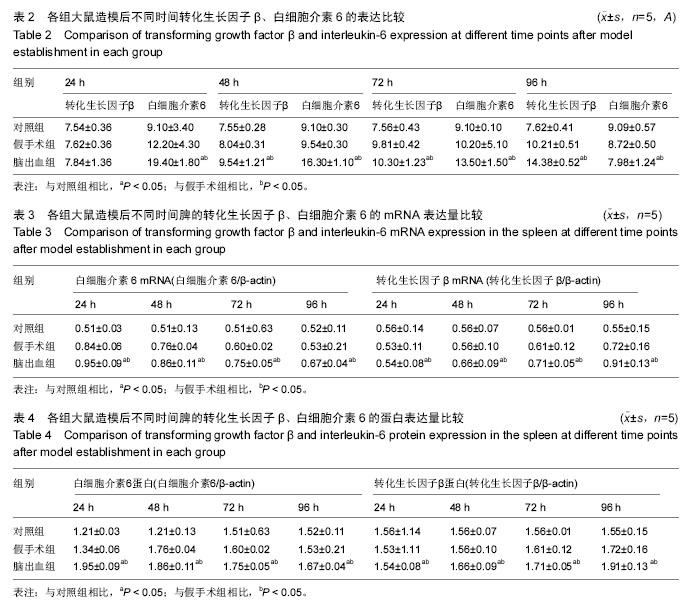中国组织工程研究 ›› 2016, Vol. 20 ›› Issue (40): 5939-5945.doi: 10.3969/j.issn.2095-4344.2016.40.002
• 脑及脊髓损伤动物模型 Animal models of brain and spinal cord injuries • 上一篇 下一篇
脑出血免疫抑制大鼠模型的构建及评估
张建军,史焕昌
- 天津市第四中心医院神经外科,天津市 300070
Immunosuppressed rat model of cerebral hemorrhage: construction and assessment
Zhang Jian-jun, Shi Huan-chang
- Department of Neurosurgery, Tianjin Fourth Central Hospital, Tianjin 300070, China
摘要:
文章快速阅读:
.jpg)
文题释义:
脑出血后免疫抑制:在临床治疗过程中观察到,脑出血患者也存在着免疫抑制现象。当前的动物实验和部分临床研究局限于缺血性脑血管病,而对病死率和死亡率明显高于前者的脑出血相关研究罕见。由于脑出血发病机制、组织损伤程度、占位效应、手术麻醉干扰等方面不同于缺血性脑血管病,此类患者多见昏迷,免疫功能变化更复杂,所以对脑出血后免疫抑制现象研究更有必要。
急性脑出血免疫大鼠模型:建立急性脑出血大鼠模型,探其发病机制,寻找有效的治疗药物逐渐引起重视。大鼠在脑出血后先呈现免疫功能亢奋,随即96 h后出现免疫功能抑制。
摘要
背景:研究表明,大鼠脑出血后经治疗可以有效抑制其免疫功能。已有文献研究对缺血性脑卒中后免疫抑制现象进行详细研究,但脑出血后机体免疫功能研究鲜见报道。
目的:构建脑出血后免疫抑制大鼠模型并进行稳定性评估。
方法:将60只Wistar大鼠随机分为3组,即对照组、假手术组、脑出血组,每组20只。采用自身动脉血50 μL注入大鼠基底节方法建造急性脑出血模型;假手术模型注入50 μL 生理盐水,手术过程同脑出血模型;对照组不做任何处理。分别于造模后24,48,72,96 h用血液分析仪检测白细胞、淋巴细胞、淋巴细胞百分数;采用ELISA测定大鼠血清中促炎细胞因子白细胞介素6和抗炎细胞因子转化生长因子β的水平;剖取大鼠脾组织进行组织学及病理学检查;通过RT-PCR及Western blotting检测转化生长因子β、白细胞介素6基因和蛋白在脾组织中的表达变化。
结果与结论:①与假手术组及对照组相比,脑出血组大鼠于造模后24,48,72,96 h白细胞数明显升高,淋巴细胞百分数逐渐降低,差异有显著性意义(P < 0.05);②与假手术组及对照组相比,脑出血组大鼠血液、脾的白细胞介素6在24 h 时高表达,72 h 达高峰,96 h时表达降低,差异有显著性意义(P < 0.05);③与假手术组及对照组相比,脑出血组大鼠血液、脾的转化生长因子β 于24 h时低表达,72 h 逐渐升高,96 h时高表达,差异有显著性意义(P < 0.05);④结果提示,大鼠在脑出血后先呈现免疫功能亢奋,随即96 h后出现免疫功能抑制,说明脑出血后免疫抑制大鼠模型造模成功,并具有良好的稳定性。
中国组织工程研究杂志出版内容重点:肾移植;肝移植;移植;心脏移植;组织移植;皮肤移植;皮瓣移植;血管移植;器官移植;组织工程
ORCID: 0000-0003-2528-3644(张建军)
中图分类号:


.jpg)